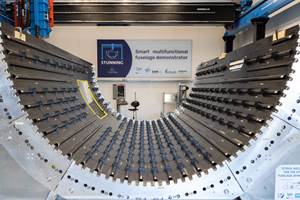Modeling and simulation: Is ICME the next composites breakthrough?
CompositesWorld columnist and composites industry consultant Dale Brosius encourages empirical learners (read "hands-on, trial-and-error old-timers") like himself to buy in and start using today's software-based design and simulation tools, which, he says, have the "potential to truly transform the composite industry."
In the July 2013 issue of CW’s predecessor, High-Performance Composites (HPC), I opined that the F-35 will be the last manned fighter aircraft. That was based on the indisputable fact that computing power will continue to grow significantly, making it possible for artificial intelligence to exceed the capabilities of human pilots in combat. I also suggested this would open up new opportunities for composites because a pilot-free aircraft could fly closer to the performance edge than a manned aircraft. In the October 2014 issue of HPC’s sister publication, Composites Technology (CT), I followed that by bemoaning the slow rate of innovation in composites compared to that of the consumer-electronics and information-technology industries. The computing power in a single smartphone exceeds that of a room full of processing hardware from 30 years ago, yet we still struggle to overcome the inherent barriers to composites in infrastructure, automobiles and aircraft.
Having spent my career in the world of “making things,” I have viewed computer-based modeling and simulation as a bunch of pretty pictures on a screen. One cannot drive to a restaurant in a virtual car or fly to Hawaii in a virtual airplane, I reasoned. (Well, you can, as in a video game, but you aren’t physically traveling … not while teleportation remains a concept in science fiction.) Real physical manufacturing — making tons of epoxy resin, laying up and curing prepregs, infusing textile preforms in a closed mold — is what puts composites into our bridges, our automobiles and the aircraft we fly. But then, most of my experience with computer modeling/simulation has been sitting next to a CAD or FEA expert, suggesting manufacturing-friendly draft angles or radii for a part, or proposing initial starting laminate schedules, then reviewing the outcomes of stress plots to determine where more material needs to be added or can be taken away. Yes, all pretty rudimentary stuff.
Over the past few years, however, I’ve been impressed with mold-filling analysis of high-pressure RTM, and with thermal modeling, which uses computational fluid dynamics of liquid heat transfer media, with improving accuracy in real-world validation. As a result, I’ve come to believe, in a big way, that computing power has the potential to truly transform the composites industry.
This past December, I attended CompositesWorld’s Carbon Fiber 2014 conference (San Diego, CA, US), and I was able to drop in on BIOVIA, a subsidiary of the software giant Dassault Systèmes (Velizy-Villacoublay, France), probably best known for the CAD program CATIA. I was given a demonstration of a product called Materials Studio, which models substances at the molecular and atomic levels, and simulates how these materials interact and interface with other materials. Such tools are already being used by the pharmaceutical industry to develop new drugs, and several advanced composite material suppliers are looking at how they might use them to design new resins and improve fiber/matrix adhesion.
In theory, the properties mapped at a molecular level could be scaled all the way to full-sized parts, with the ability to accurately predict the performance of an aircraft wing or a vehicular bridge without having to build and test numerous coupons and sub-elements. The term Integrated Computational Materials Engineering, or ICME, has been coined to define this concept. Although I believe we are still some years away from being able to span this entire range, there are numerous computational tools out there today that — properly integrated — offer the ability to take basic materials data, assemble it, and help us to design both parts and manufacturing processes. This would reduce costs and enhance the acceptance of composites.
So, what will it take to make all this a reality? First and foremost, there needs to be considerable cooperation among the various simulation/design software companies. Competitors will need to collaborate to ensure that digital designs can be incorporated into models that predict crash behavior and then translate to simulation tools that predict manufacturing parameters, such as pressure, time and temperature. This, in turn, will ensure a good part without excessive voids or other defects. And that will involve common protocols for exchanging information. Hosting these disparate tools on a single platform, such as the evolving Composites Design and Manufacturing Hub (cdmHUB) at Purdue University, is a major step in getting all the software providers to work together.
Even more important is getting all us manufacturing “old-timers” to buy in and start using these software tools, especially the more sophisticated ones, to reduce the amount of empirical learning during the product development process. We can be a stubborn bunch, and will need to see lots of real-world validation of this method on the shop floor. I know I’m ready — and I believe a lot of others will be as well.
Related Content
Composite sidewall cover expands options for fire-safe rail components
R&D project by CG Rail explores use of carbon fiber-reinforced thermoplastics and recycled manufacturing scrap to meet fire safety, weight and volume targets.
Read MoreThermoset-thermoplastic joining, natural fibers enable sustainability-focused brake cover
Award-winning motorcycle brake disc cover showcases potential for KTM Technologies’ Conexus joining technology and flax fiber composites.
Read MorePlant tour: National Institute for Aviation Research, Wichita, Kan., U.S.
NIAR, located at Wichita State University in the heart of the American aerospace manufacturing industry, has evolved to become a premier hub of teaching, R&D, creativity and innovation.
Read MoreThermoplastic composites welding: Process control, certification, crack arresters and surface prep
More widespread use of welded composite structures within a decade? Yes, but further developments are needed.
Read MoreRead Next
CW’s 2024 Top Shops survey offers new approach to benchmarking
Respondents that complete the survey by April 30, 2024, have the chance to be recognized as an honoree.
Read MoreComposites end markets: Energy (2024)
Composites are used widely in oil/gas, wind and other renewable energy applications. Despite market challenges, growth potential and innovation for composites continue.
Read MoreFrom the CW Archives: The tale of the thermoplastic cryotank
In 2006, guest columnist Bob Hartunian related the story of his efforts two decades prior, while at McDonnell Douglas, to develop a thermoplastic composite crytank for hydrogen storage. He learned a lot of lessons.
Read More












.jpg;maxWidth=300;quality=90)













